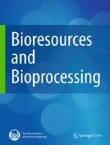Lead Guest Editor: Jie Bao
Lead Guest Editor: Bin Zhang
The conversion of readily available, inexpensive, sustainable agro-industrial and municipal waste into chemicals and biofuels through biorefinery processing shows great promises in terms of sustainability and carbon-neutrality. However, recent industrial demonstrations have highlighted the low efficiency of biorefinery processing with very low production levels and high waste emissions. There is an urgent need to improve the key performance indicators (KPI) of biorefinery processing to match or exceed those of starch-based industrial fermentations. These KPIs should include, but not be limited to, product titer, productivity, and conversion ratio. Additionally, waste emissions (such as wastewater and toxins) should be reduced to levels similar to those of starch-based fermentation. To achieve this, one core approach is to increase the lignocellulose solids loading at each step of the biorefinery processing chain, including pretreatment, hydrolysis, detoxification, fermentation, and purification. This is an essential requirement for the next generation of biorefinery engineering technology and industrial applications.
Bioresources and Bioprocessing (BIOB) plans to organize a Thematic Issue with the subject of “Biorefinery Processing under High Solids Loading” during May, 2023-April, 2024. All researchers working in the field of high solids loading biorefinery processing (pretreatment, detoxification, saccharification, fermentation/digestion, techno-economic evaluation, carbon-neutral evaluation) are cordially encouraged to submit their original articles including research articles, short reports and reviews to this SCI-indexed open-access journal which is published by the Springer-Nature group. Starting from January 2022, article-processing charges (APCs) are applied to all accepted manuscript. But to encourage submission, the State Key Laboratory of Bioreactor Engineering, as the host of BIOB, is willing to offer a 20% discount of the APC after negotiation with the publisher. The Impact Factor of BIOB (2021) is 4.983, ranking No. 47/159 in the JCR category of Biotechnology and Applied Microbiology.
The topics of interest include, but are not limited to:
- High-solids loading pretreatment of various agro-industrial and municipal wastes.
- Development of a newly designed cellulase cocktail and reactor for high solids loading saccharification.
- High-solids loading fermentation or simultaneous saccharification and co-fermentation (SSCF).Toxification without the need for water washing or wastewater generation at high solids loading.
- Novel biorefinery platform with high production efficiency.
- Techno-economic and carbon-neutral evaluations.
The minimum KPIs include:
- The feedstocks used for biorefinery processing under high solids loading include typical agricultural crop residues, forest residue, agro-industrial waste, municipal waste, and other non-food biomass such as corn stover, wheat straw, rice straw, wood biomass, bamboo residue, sugarcane bagasse, palm empty fruit bunch, and Jerusalem artichoke, etc. However, the feedstocks derived from starch, sucrose, or other food crops or sugar biomass are excluded.
- For the production of cellulosic ethanol, the final ethanol concentration in fermentation broth should be at least 55 g/L (equivalent to ~70% of the minimum industrial ethanol production level of 10%, v/v) within a reasonable processing period.
- For the production of cellulosic L- or D-lactic acids, the final lactic acid concentration in fermentation broth should be at least 100 g/L (the minimum for organic acid production in industrial fermentations) within a reasonable processing period.
- Similar requirements apply for production of biofuels or biochemicals other than ethanol and lactic acid.
All papers and supplementary information (if any) should be submitted online (http://www.editorialmanager.com/biob/default.aspx) and prepared according to the BIOB guidelines (http://bioresourcesbioprocessing.springeropen.com/submission-guidelines). Authors should indicate that the paper is submitted for the thematic issue of High Solids Loading Biorefinery Processing in their cover letter and is not published or being considered to publish elsewhere. All submissions will be subject to peer review before possible acceptance for publication in BIOB which is highly accessed by readers from all over the world and has an opportunity to be selected as monthly highlights for promotion on the journal webpage and/or social media like Facebook and WeChat.
The date open for submission to the thematic issue of Biorefinery Processing under High Solids Loading: From Now On;
Until the deadline: April 30, 2024.
